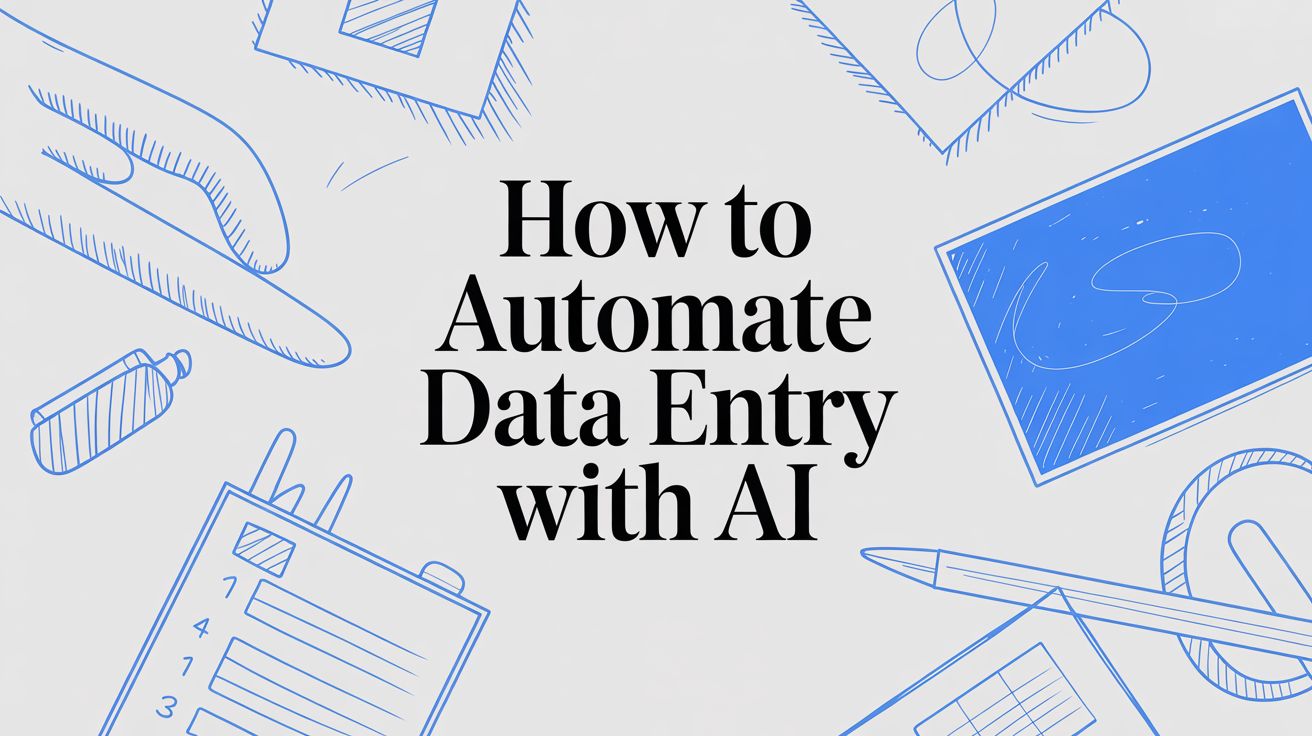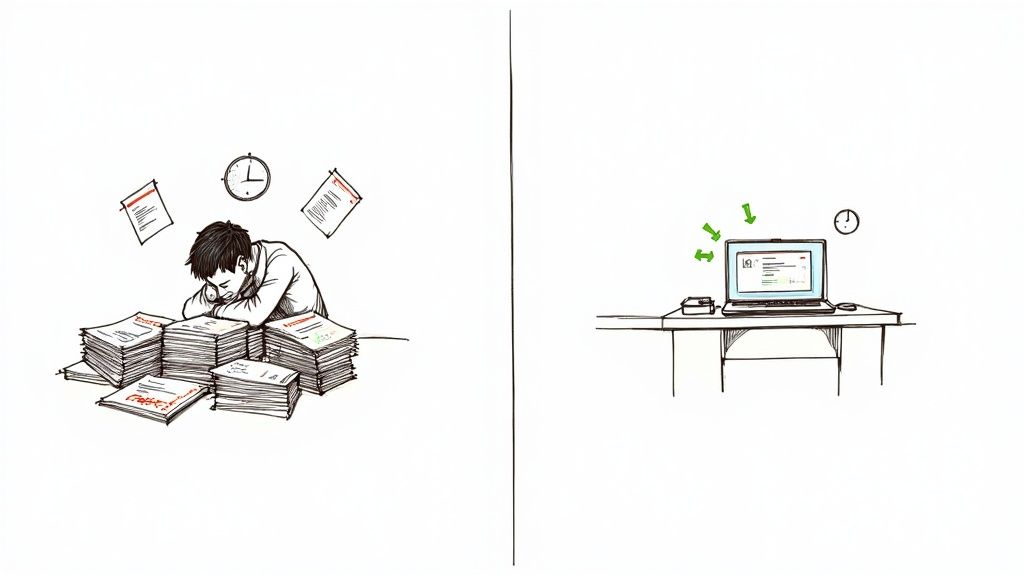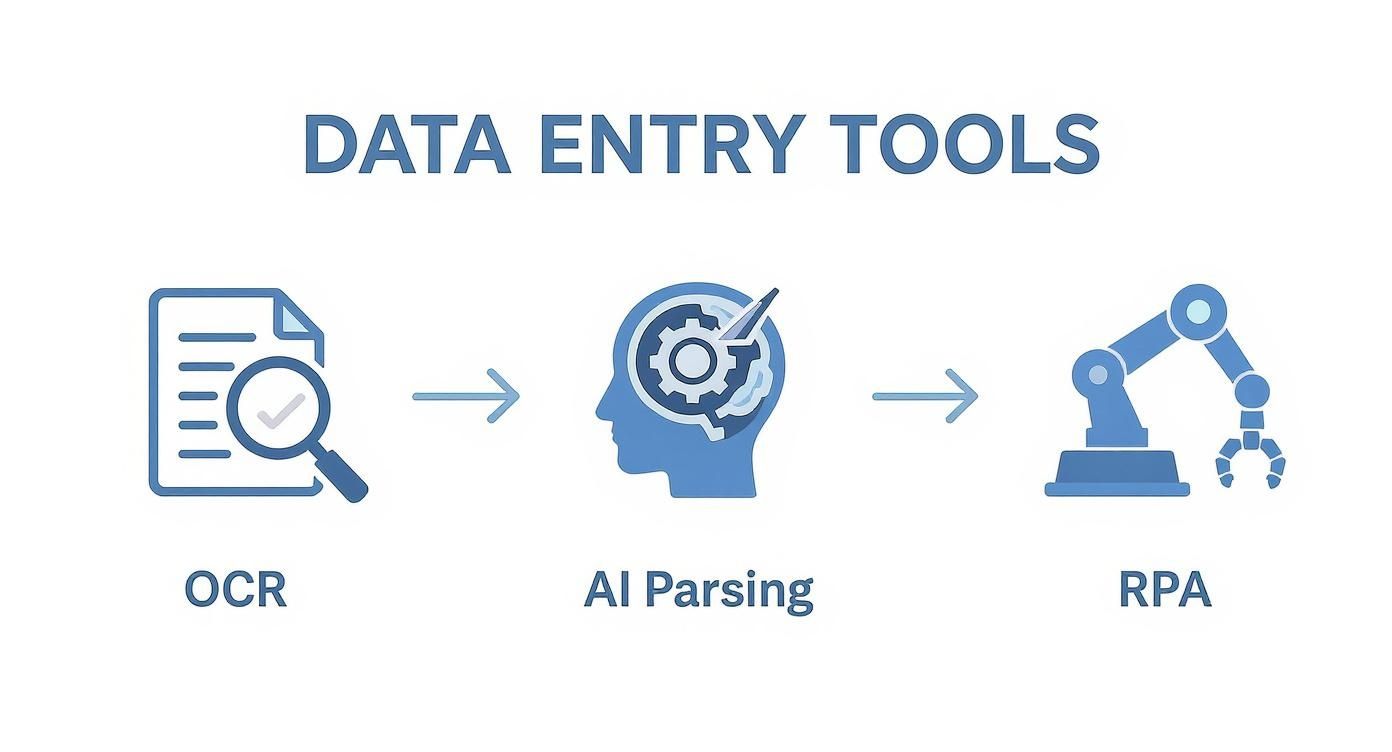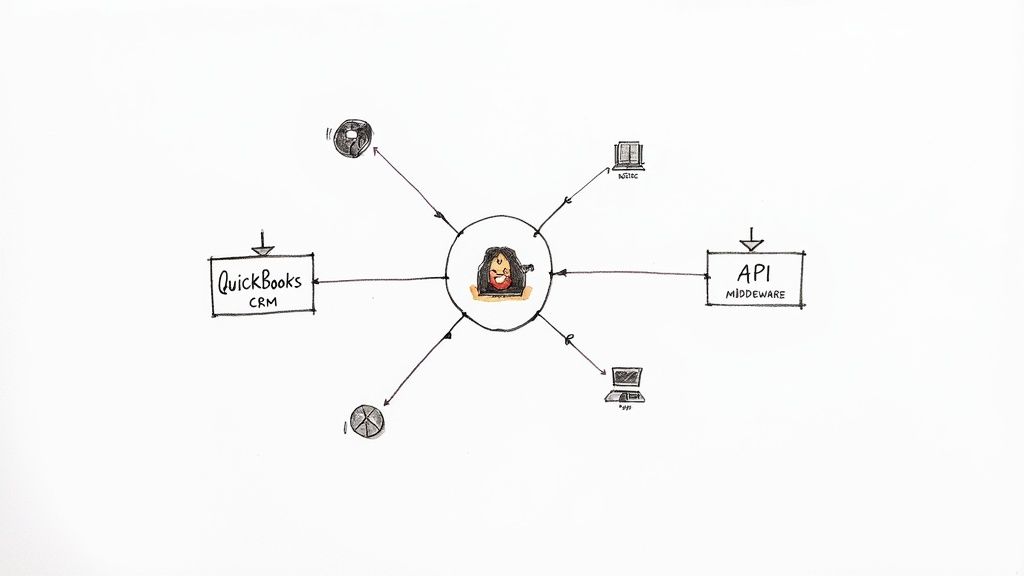
How to Automate Data Entry with AI
The secret to automating data entry lies in AI-powered document parsing tools. These smart systems can pull specific information right out of files like PDFs, scanned receipts, and images, then send that data exactly where it needs to go in your business software. It all happens thanks to technologies like Optical Character Recognition (OCR), which turns what was once a mind-numbing manual task into a fast, accurate, and scalable process. The result? A workflow that saves countless hours and slashes costly errors.
Why Manual Data Entry Is Obsolete
If you've ever lost an afternoon to typing invoice details into a spreadsheet, you understand the soul-crushing reality of manual data entry. It’s a universal pain point—a monotonous, error-prone chore that kills productivity and morale. For so many businesses, this is the "before" picture: a mess of typos, wasted hours, and sheer boredom.
The problem isn't your team's effort; it's the process itself. Even the most careful employee will eventually make mistakes when faced with that level of repetition. And those tiny errors, like a misplaced decimal or a mistyped invoice number, can snowball into huge problems, causing everything from delayed payments to completely inaccurate financial reports.

The Staggering Cost of Human Error
Moving to automation isn't just about saving time; it's a strategic decision to protect the integrity of your data. The difference in accuracy alone is eye-opening. As of 2025, automated systems consistently achieve accuracy rates between 99.959% and 99.99%. In contrast, human accuracy for the same tasks hovers between 96% and 99%.
What does that look like in the real world? For every 10,000 pieces of data entered, an automated system will make just 1 to 4.1 errors. A person doing the same job will make between 100 and 400 errors.
To really see the difference, let's put them side-by-side.
Manual vs Automated Data Entry: A Quick Comparison
| Metric | Manual Data Entry | Automated Data Entry |
|---|---|---|
| Accuracy | 96%–99% | 99.959%–99.99% |
| Speed | Slow, limited by human typing speed | Near-instantaneous |
| Cost | High labor costs, plus cost of fixing errors | Lower operational costs, subscription-based |
| Scalability | Poor; requires hiring more people | Excellent; handles volume spikes easily |
| Employee Focus | Tedious, repetitive transcription | High-value, strategic tasks |
This table clearly shows why AI-powered automation is the "after" picture. It's no longer some complex, out-of-reach technology. It's an accessible solution that fundamentally improves your workflow, making it not just faster, but far more reliable.
The goal is to reframe how we think about data entry—from a necessary evil performed by people to a seamless, background process handled by technology. This frees up your team to focus on analysis and decision-making, not just data transcription.
A Smarter Way to Work
At its core, this shift is driven by a combination of Optical Character Recognition (OCR) and artificial intelligence. Modern systems don't just "read" the text on a page; they understand its context. They can identify key information like invoice dates, totals, and vendor names, even if the document's layout is completely different from the last one.
If you're curious about the mechanics behind it all, you can learn more about what OCR technology is and how it powers this entire process in our detailed guide.
Choosing Your Data Entry Automation Toolkit
Navigating the crowded market for automation software can feel like a full-time job. With so many options out there, the real trick is to match the technology to your specific problem—not the other way around. To figure out how to best automate data entry for your business, you first need to understand the main types of tools available.
Your decision will likely boil down to one of three core technologies: Optical Character Recognition (OCR), Robotic Process Automation (RPA), and specialized AI-powered document parsing platforms. Each one solves a different kind of problem and scales in its own way. A basic OCR tool might be fine for digitizing a few standard forms, but it will quickly fall apart when faced with invoices from a dozen different vendors.
This whole field is exploding right now. The industrial automation market is on track to hit $226.8 billion by 2025, and different parts of the world are leading the charge in different areas. While the Asia-Pacific region is a giant in industrial automation, North America is way ahead when it comes to automating financial processes. You can dig into more of these automation industry insights on thunderbit.com. For you, this growth is a good thing—it means more powerful and user-friendly tools are hitting the market all the time.
When to Use Each Type of Tool
Think of it like working with tools in a workshop. You wouldn't use a sledgehammer to hang a picture frame, right? The same logic applies here.
-
Basic OCR Tools: These are your digital scanners. They're great for one simple job: turning straightforward, consistent documents (like a standardized internal form) from an image into plain text. They are usually cheap but don't have the smarts to understand context or handle messy, real-world layouts.
-
Robotic Process Automation (RPA): This is the heavy machinery. RPA bots are programmed to mimic what a human does on a computer—clicking buttons, copying data from a spreadsheet and pasting it into a web form, and following rigid, rule-based scripts. It’s a beast for high-volume, repetitive tasks that span multiple systems, but be warned: it can be complex and costly to get running and even more of a headache to maintain.
-
AI Document Parsing Platforms: This is the smart, flexible sweet spot. These platforms use AI to not just read the text, but to actually understand what it means. They can spot an "invoice number" or "due date" on documents from hundreds of different suppliers, even if the formatting, location, and wording are completely different on each one. This approach is what we call Intelligent Document Processing.
My Take: It all comes down to your document complexity and your workflow. If you're trying to pull structured data from all sorts of messy documents like invoices or receipts, an AI parsing platform gives you the best mix of power, flexibility, and ease of use.
If you're curious, you can learn more about what Intelligent Document Processing is and how it's a huge leap forward from basic OCR in our detailed guide.
Visualizing an RPA Workflow
An RPA system is really just a digital robot following a very specific set of instructions you give it.
This diagram gives you a good look at a typical RPA setup, where a software "bot" is the middleman between different applications.
This bot essentially acts like a digital employee. It can pull information from one place (like an email attachment) and push it into another (like your CRM or accounting software), all without anyone having to lift a finger.
For a small business that just wants to process supplier invoices, a full-blown RPA implementation is probably overkill. An AI document parsing tool, on the other hand, can nail the extraction part. That clean, structured data can then be fed into a much simpler workflow, giving you all the accuracy benefits without the massive complexity.
Putting Your First Automated Workflow Together
Alright, you've picked your tool. Now it's time for the fun part: taking this from a concept on a whiteboard to a real, working process. This is where you'll see the magic happen and start building a workflow that actually saves you time and cuts down on those pesky data entry mistakes.
My biggest piece of advice? Don't try to boil the ocean. Start small and pick one, high-impact document to focus on. Supplier invoices are a perfect starting point for most businesses.
Your goal should be crystal clear. For instance, you might decide: "I want to automatically pull the invoice number, vendor name, due date, and total amount from every PDF invoice we get and pop that data into a Google Sheet." A specific, manageable goal like this is the secret to getting a win on the board early.
Teaching the AI What to Look For
The first hands-on step is to show your AI tool what information you care about. This is often called creating a document model or a template. Think of it like giving the AI a cheat sheet for your documents. You're basically pointing out the important stuff so it knows what to grab, no matter how the layout changes from one document to the next.
With a tool like DocParseMagic, you'd typically upload a sample invoice and literally draw boxes around the fields you need. You'd label one box "VendorName," another "InvoiceTotal," and you get the idea. The AI then starts to learn how to spot these details based on their position, nearby keywords, and the overall document structure. For a deeper dive into how this works, our guide on how to extract data from documents breaks it all down.
This infographic gives you a great visual of how a document goes from a static file to structured, usable data.

As you can see, it's a three-part journey: OCR turns the image into text, the AI parser figures out what that text means, and then automation tools (like RPA) push that organized data into your other software.
Test, Tweak, and Refine Your Model
Once you've got that initial model built, it's time to put it through its paces. Testing isn't just a pass/fail exercise; it's how you make the AI smarter. I recommend gathering a small but varied batch of sample documents—maybe 10 to 15 different invoices from a mix of your suppliers. That should be enough to see how it handles different layouts.
Run them through your new setup. The AI will do its best to pull the data based on what you taught it. Now it's your turn to play quality control. Did it grab the right total? Did it mix up the invoice date with the due date? Most platforms make this easy by showing you the extracted data right next to the original document, so you can quickly spot-check everything.
Key Takeaway: Every time you fix a mistake or confirm a correct piece of data, you're training the AI. This feedback loop is what makes the model more accurate and dependable over time. Don't skip this step!
Plan for the Weird Stuff: Rules and Exceptions
Let's be realistic: no system is foolproof, and you're going to get documents that don't play by the rules. Maybe one vendor insists on using a funky date format, or another breaks out five different tax lines you need to add together. This is where you need to set up your business rules and plan for exception handling.
Think of these as simple "if-then" instructions for your workflow:
- Data Formatting: If a date shows up as "MM-DD-YYYY," create a rule to automatically change it to "YYYY-MM-DD" so it matches the format in your database.
- Simple Math: If the document has separate "Subtotal" and "Tax" fields, tell the system to add them together and create a new "GrandTotal" field.
- Handling the Blanks: If an invoice is missing a crucial piece of info, like an invoice number, set a rule to flag it for a human to look at instead of pushing bad data through.
Building in these guardrails from the start is what separates a fragile automation from a truly robust and intelligent one. It ensures the data hitting your systems is clean, consistent, and ready to use. This isn't just a neat trick; it's part of a massive shift in how businesses operate. Looking ahead to 2025, even though 94% of companies will still have people doing repetitive tasks, automation is already making work better for 90% of knowledge workers and increasing productivity for 66%. You can dig into more of these powerful workflow automation statistics on kissflow.com.
Getting Automation to Talk to Your Business Systems
An automation tool that doesn't connect to your other software is like having a brand-new engine with no car to put it in. It's powerful, but it's not going anywhere. The real magic happens when the clean, structured data you’ve just extracted flows right into the systems you use every day. This is the integration phase, and it’s where you build the digital plumbing for a truly hands-off workflow.
The best way to connect everything depends entirely on what you're already using—your tech stack. There's no single "right" answer, so you'll need to find the approach that fits your setup. Thankfully, for most businesses, this is easier than it sounds.
- Native Integrations: This is the dream scenario. If your AI tool has a direct, one-click connection to software you already use, like QuickBooks Online or Xero, go with that. These connections are built and maintained by the provider, making them the most stable and reliable option.
- Middleware Platforms: Think of services like Zapier or Make as universal adapters for your apps. They let you build simple "if this happens, then do that" recipes to connect thousands of different tools, all without needing to write a line of code.
- Custom API Development: For companies with specialized, in-house software (like a custom-built CRM or ERP), a flexible Application Programming Interface (API) is non-negotiable. This gives your development team the power to build a bespoke connection that does exactly what you need.
Using Middleware Like Zapier
If you're trying to sync up multiple cloud-based tools, a middleware platform is often the perfect go-between. This screenshot from Zapier, for instance, shows just how intuitive these tools can be. It lays out your entire workflow visually, connecting different apps in a logical sequence.

Each step in this "Zap" triggers the next one, creating a chain reaction that automatically moves data from your parser to its final home. This visual approach makes what used to be a complex technical task something anyone on your team can understand and manage.
Nailing Your Data Mapping
Okay, so your systems are connected. Now for the other half of the puzzle: telling the data exactly where to go. This is called data mapping, and it's simply the process of matching the fields from your original document to the correct fields in the destination software.
Don't rush this step—it’s what stands between order and chaos. You need to be sure that the field you labeled "Total Amount" from an invoice ends up in the "Transaction_Value" column in your accounting software, not the "Customer_ID" field. A simple mix-up here could throw your financial reports completely out of whack.
Pro Tip: Before you finalize the integration, sketch out a quick data map in a spreadsheet. Create two columns: one for the field names from your AI parser and one for the corresponding field names in your target system. This simple checklist can save you a massive headache later.
Most integration tools make this pretty easy with a visual interface. You'll typically see a list of the data points extracted from your document, and you can just drag-and-drop or select them to match the input fields in the other application.
Finally, always run a few tests before you flip the switch. Process a real-world document and trace its path from start to finish. Check that every single piece of data landed in the right spot and in the right format. This final confirmation ensures your automated system is not just running, but running perfectly.
How to Optimize and Scale Your Automated Workflow
Getting your first automated workflow up and running is a fantastic milestone, but it's really just the starting line. The real magic happens when you start refining and improving what you've built. Once the system is live, your job shifts from building the engine to fine-tuning it for maximum performance.
Think of your new automation as a brand-new employee. It's incredibly fast and doesn't make typos, but it still needs guidance to learn the ropes. This is where a human-in-the-loop (HITL) process is so valuable.
Instead of having someone double-check every single document, you can set the system to flag only the entries it's unsure about. For instance, if the AI is only 75% confident it read a messy, handwritten invoice number correctly, it can route just that one field to a team member for a quick look.
This is a game-changer for efficiency. Your team goes from mind-numbing data entry to spending a few seconds here and there confirming exceptions. Better yet, every correction they make teaches the AI, improving its accuracy for the next batch of documents.
Monitoring Performance and Proving Value
So, how do you know if all this is actually working? You need to track it. Gut feelings are great, but hard data is what proves the value of your efforts and justifies expanding the project.
I recommend focusing on a few critical metrics that tell the real story:
- Accuracy Rate: What percentage of data fields are being extracted perfectly, with zero human touch? This is your north star. For context, even the best manual data entry has an error rate of around 1%. A well-trained AI can get much, much closer to perfect.
- Processing Time: Clock the entire journey. How long does it take for a document to go from being uploaded to being usable in your system? This metric directly shows your speed and efficiency gains.
- Cost Savings: This is the metric that gets executives' attention. Tally up the hours your team is no longer spending on manual entry and put a dollar figure on it. This is your ROI, plain and simple.
The secret is to create a tight feedback loop: monitor your numbers, find the weak spots, make small tweaks to the process or the AI model, and then measure again. This constant cycle of refinement is what separates a decent automation from a truly great one.
Scaling Your Automation Efforts
Once your first workflow is a well-oiled machine, it's time to ask, "What's next?" Scaling doesn't just mean throwing more documents at the same process; it means finding new problems to solve.
Look around your company for other paper-heavy, repetitive tasks. Could the same tech handle purchase orders in procurement? What about expense receipts from the sales team or new client onboarding forms?
When you're ready to expand to a new department, don't just show up and announce a new system. Start with a pilot project. Use the success story from your initial workflow to get them on board. Show them your dashboard with the hard numbers—the time saved, the accuracy gained, the costs cut.
When other teams see the tangible results, they won't need convincing. They'll be asking you to help them next. This is how you build momentum and turn a single successful project into a fundamental shift in how your entire company operates.
Got Questions About Automating Data Entry?
As you start thinking about automating data entry, you're bound to have some questions. It’s only natural. Getting these cleared up is the final step before you can feel confident moving forward and making the right call for your business.
Let’s dive into some of the most common things people ask about cost, security, and whether the tech can really handle real-world documents.
How Much Does It Cost to Automate Data Entry?
The investment can swing pretty wildly, but it's often more affordable than you might guess. Sure, you can find cheap OCR tools, but they’re usually pretty basic and stumble when faced with anything other than a perfectly formatted document.
Most modern AI platforms run on a subscription model tied to how many documents you process. You'll see plans starting around $50 a month and going up to several hundred, which lets the cost scale with your needs. The really big investment is a full-blown Robotic Process Automation (RPA) system, but honestly, that's usually overkill if you're just focused on document processing.
Here's the thing: it’s not just about the sticker price. It's about the return on that investment. When you find a tool that saves your team hours of mind-numbing work and drops your error rate from 1% to practically zero, the subscription often pays for itself many times over in saved labor and fewer costly mistakes.
Is Automated Data Entry Secure for Sensitive Documents?
That’s a big one, and rightly so. The short answer is yes—as long as you pick the right partner. Any reputable platform in this space makes security a top priority and builds their entire system around protecting your data.
When you're looking at different options, keep an eye out for compliance with standards like SOC 2 and GDPR. These aren't just fancy acronyms; they mean the company has passed some serious third-party audits on their security practices.
A few other non-negotiables to look for:
- End-to-end data encryption: This protects your information while it's being uploaded, processed, and stored.
- Secure data centers: You want to know they have strong physical and digital protections in place.
- Role-based access controls: This is crucial for making sure only the right people on your team can see or handle sensitive data.
I always tell people to take five minutes to read a vendor’s security and privacy policies. It's a small step that gives you huge peace of mind before you start uploading financial records or customer info.
Can AI Automation Handle Handwritten Text or Complex Layouts?
This is where modern AI really shines compared to old-school OCR. Today’s systems are much better equipped to handle the messy, inconsistent documents that are part of everyday business.
AI models are trained to grasp the context of a document, not just recognize characters. That’s how they can look at two invoices from different suppliers, with completely different layouts, and still know exactly where to find the invoice number and total amount. Many can even read clear handwriting with a surprisingly high degree of accuracy.
That said, performance isn't universal. One tool might be great with your forms but struggle with your invoices. This is why a free trial is so important—always test-drive a platform with your own real-world documents to make sure it can handle what you throw at it.
Ready to see how simple and powerful AI-powered automation can be? DocParseMagic eliminates manual data entry by extracting key information from your invoices, receipts, and forms directly into a spreadsheet in under a minute. Start your free trial and automate your first documents today at https://docparsemagic.com.